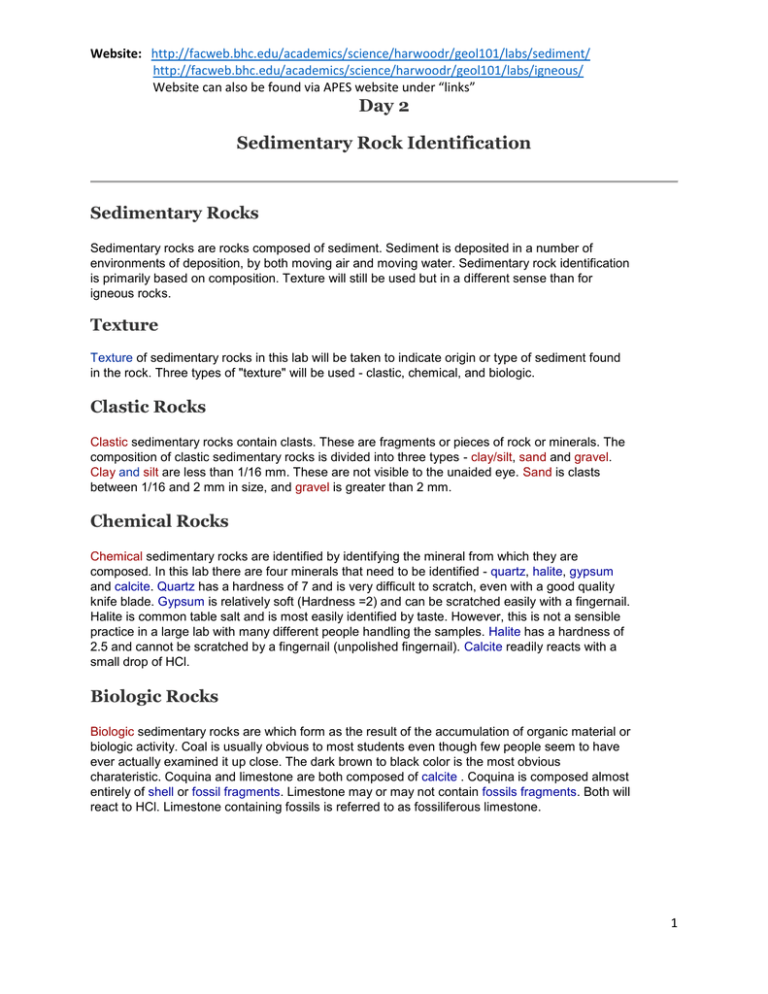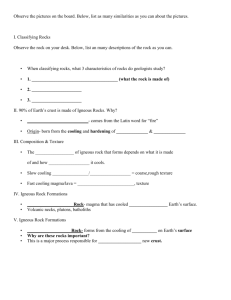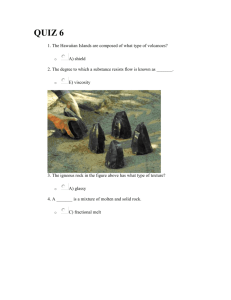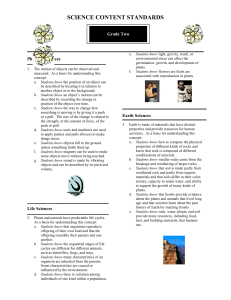Sedimentary & Igneous Rock ID- Virtual Lab
advertisement

Website: http://facweb.bhc.edu/academics/science/harwoodr/geol101/labs/sediment/ http://facweb.bhc.edu/academics/science/harwoodr/geol101/labs/igneous/ Website can also be found via APES website under “links” Day 2 Sedimentary Rock Identification Sedimentary Rocks Sedimentary rocks are rocks composed of sediment. Sediment is deposited in a number of environments of deposition, by both moving air and moving water. Sedimentary rock identification is primarily based on composition. Texture will still be used but in a different sense than for igneous rocks. Texture Texture of sedimentary rocks in this lab will be taken to indicate origin or type of sediment found in the rock. Three types of "texture" will be used - clastic, chemical, and biologic. Clastic Rocks Clastic sedimentary rocks contain clasts. These are fragments or pieces of rock or minerals. The composition of clastic sedimentary rocks is divided into three types - clay/silt, sand and gravel. Clay and silt are less than 1/16 mm. These are not visible to the unaided eye. Sand is clasts between 1/16 and 2 mm in size, and gravel is greater than 2 mm. Chemical Rocks Chemical sedimentary rocks are identified by identifying the mineral from which they are composed. In this lab there are four minerals that need to be identified - quartz, halite, gypsum and calcite. Quartz has a hardness of 7 and is very difficult to scratch, even with a good quality knife blade. Gypsum is relatively soft (Hardness =2) and can be scratched easily with a fingernail. Halite is common table salt and is most easily identified by taste. However, this is not a sensible practice in a large lab with many different people handling the samples. Halite has a hardness of 2.5 and cannot be scratched by a fingernail (unpolished fingernail). Calcite readily reacts with a small drop of HCl. Biologic Rocks Biologic sedimentary rocks are which form as the result of the accumulation of organic material or biologic activity. Coal is usually obvious to most students even though few people seem to have ever actually examined it up close. The dark brown to black color is the most obvious charateristic. Coquina and limestone are both composed of calcite . Coquina is composed almost entirely of shell or fossil fragments. Limestone may or may not contain fossils fragments. Both will react to HCl. Limestone containing fossils is referred to as fossiliferous limestone. 1 Website: http://facweb.bhc.edu/academics/science/harwoodr/geol101/labs/sediment/ http://facweb.bhc.edu/academics/science/harwoodr/geol101/labs/igneous/ Website can also be found via APES website under “links” Sedimentary Rock Identification Chart TEXTURE Clastic GRAIN SIZE COMPOSITION ROCK NAME >2 mm rounded quartz, feldspar and rock fragments Conglomerate >2 mm angular quartz, feldspar and rock fragments Breccia 1/16 - 2 mm quartz, feldspar Sandstone >1/16 mm feldspar, quartz Arkose <1/16 mm quartz, clay minerals Siltstone (Mudstone, Shale) <1/256 mm quartz, clay minerals Claystone silica (quartz) Chert dolomite Dolostone calcite Limestone halite Rock Salt gypsum Rock Gypsum silica (quartz) Chert loosely compacted organic material and plant fragments Peat densely compacted organic material and plant fragments Bituminous Coal calcite Limestone calcite, micro-skeletal fragments Chalk calcite, almost entirely shell and skeletal fragments Coquina calcite with some shell and skeletal fragments Fossiliferous Limestone dolomite with some shell and skeletal fragments Fossiliferous Dolostone Chemical Biologic Select a Sample to Identify: 1 2 3 4 5 6 7 8 9 10 11 12 • • • • • • • • • • • 2 Website: http://facweb.bhc.edu/academics/science/harwoodr/geol101/labs/sediment/ http://facweb.bhc.edu/academics/science/harwoodr/geol101/labs/igneous/ Website can also be found via APES website under “links” Directions: For samples 1 -12 list the texture, grain size, composition and rock type Sample 1 Texture Grain Size Composition Rock Type Name of Rock Sample 2 Texture Grain Size Composition Rock Type Name of Rock Sample 3 Texture Grain Size Composition Rock Type Name of Rock Sample 4 Texture Grain Size Composition Rock Type Name of Rock 3 Website: http://facweb.bhc.edu/academics/science/harwoodr/geol101/labs/sediment/ http://facweb.bhc.edu/academics/science/harwoodr/geol101/labs/igneous/ Website can also be found via APES website under “links” Sample 5 Texture Grain Size Composition Rock Type Name of Rock Sample 6 Texture Grain Size Composition Rock Type Name of Rock Sample 7 Texture Grain Size Composition Rock Type Name of Rock Sample 8 Texture Grain Size Composition Rock Type Name of Rock Sample 9 Texture Grain Size Composition Rock Type Name of Rock \ 4 Website: http://facweb.bhc.edu/academics/science/harwoodr/geol101/labs/sediment/ http://facweb.bhc.edu/academics/science/harwoodr/geol101/labs/igneous/ Website can also be found via APES website under “links” Sample 10 Texture Grain Size Composition Rock Type Name of Rock Sample 11 Texture Grain Size Composition Rock Type Name of Rock Sample 12 Texture Grain Size Composition Rock Type Name of Rock Conclusion Question: What did you learn about sedimentary rock that you did not know before? 5 Website: http://facweb.bhc.edu/academics/science/harwoodr/geol101/labs/sediment/ http://facweb.bhc.edu/academics/science/harwoodr/geol101/labs/igneous/ Website can also be found via APES website under “links” Day 3 Igneous Rock Identification Igneous Rocks Igneous rocks are rocks which solidify from molten material (magma). Cooling of the magma can occur beneath the surface (plutonic) or on the surface (volcanic). Igneous rocks can be identified by the determination of the composition and texture of the rock. Once these two characteristics have been identified, the Igneous Rock Identification chart is used to identify the rock name. Igneous Rock Identification Chart COMPOSITION Felsic Intermediate Mafic Ultramafic TEXTURE Pegmatitic Granite Pegmatite Diorite Pegmatite Gabbro Pegmatite Phaneritic Granite Diorite Gabbro Aphanitic Rhyolite Andesite Basalt Porphyritic Rhyolite Andesite Basalt Glassy Vesicular Pyroclastic Obsidian Pumice Dunite Basaltic Glass Scoria Volcanic Tuff Composition Composition of igneous rocks is properly identified by determination of the rock's chemical composition. This, however, requires chemical equipment and apparatus that is unavailable in this lab. Fortunately determination of the exact chemical composition is not necessary. Color is often an indicator of the composition of a rock or mineral and can be effectively used to identify the composition of most igneous rocks. Light colors, including white, light gray, tan and pink, indicate a felsic composition. Felsic compositions are rich in silica (SiO2). Dark colors, such as black and dark brown, indicate a mafic or ultramafic composition. Mafic compositions are poor in silica, but rich in iron (Fe) and magnesium (Mg). Intermediate compositions have an intermediate color, often gray or consisting of equal parts of dark and light mineral . Beware that even though an igneous rock may have a felsic composition (light color), the rock can contain dark colored minerals. Mafic rocks may contain light colored minerals as well. As mentioned above, the composition of most igneous rocks can be identified using this system, formally known as the Color Index. However, there are exceptions. The two most notable are obsidian and dunite. Obsidian is volcanic glass which erupts as a lava flow. Most obsidian is felsic in composition, yet typically it will have a very dark color (dark brown to black). Dunite has an ultramafic composition yet is apple green to yellowish green in color. Dunite is composed almost entirely of the mineral olivine which usually contains both iron and magnesium. 6 Website: http://facweb.bhc.edu/academics/science/harwoodr/geol101/labs/sediment/ http://facweb.bhc.edu/academics/science/harwoodr/geol101/labs/igneous/ Website can also be found via APES website under “links” Texture The texture of an igneous rock does not refer to the roughness or smoothness of the surface. Textures are based primarily on crystal size. Pegmatitic texture is composed of very large crystals (larger than 2-3 cm). Phaneritic texture is composed of crystals which are large enough to see but smaller than pegmatitic texture, and the entire rock is composed of crystals. Aphanitic texture is a fine grained texture but the crystals are too small to see. Porphyritic texture is composed of crystals of two different sizes. Typically the large crystals (phenocrysts) are visible while the smaller crystal are not (referred to as groundmass). Glassy texture is the most readily recognized. The rock is composed entirely of glass. Few, if any, crystals will be visible. Vesicular texture is formed when lava solidifies before gases are able to escape. The result is a "bubbly" appearance. Lastly, pyroclastic texture is composed of volcanic fragments. These fragments or clasts can be very fine (ash) or coarse (lapilli) or very coarse (bombs and blocks). Sample Identification On each of the following pages you will find an image of a rock and a Igneous Rock Identification Chart. Identify the composition by identifying the color and determine the texture by examining the crystal sizes that are present. Once this is done the rock name is easily determined using the Classification of Igneous Rock chart. Click each answer, then check to see if you have correctly identified the rock sample. Select a Sample to Identify: 1 2 3 4 5 6 7 8 9 10 11 12 • • • • • • • • • • • 7 Website: http://facweb.bhc.edu/academics/science/harwoodr/geol101/labs/sediment/ http://facweb.bhc.edu/academics/science/harwoodr/geol101/labs/igneous/ Website can also be found via APES website under “links” Directions: For samples 1 -12 list the texture, composition and rock type Sample 1 Texture Sample 2 Texture Sample 3 Sample 4 Composition Rock Type Name of Rock Composition Rock Type Name of Rock Texture Composition Rock Type Name of Rock Texture Composition Rock Type Name of Rock 8 Website: http://facweb.bhc.edu/academics/science/harwoodr/geol101/labs/sediment/ http://facweb.bhc.edu/academics/science/harwoodr/geol101/labs/igneous/ Website can also be found via APES website under “links” Sample 5 Texture Composition Rock Type Name of Rock Sample 6 Texture Composition Rock Type Name of Rock Sample 7 Texture Composition Rock Type Name of Rock Sample 8 Texture Composition Rock Type Name of Rock Sample 9 Texture Composition Rock Type Name of Rock \ 9 Website: http://facweb.bhc.edu/academics/science/harwoodr/geol101/labs/sediment/ http://facweb.bhc.edu/academics/science/harwoodr/geol101/labs/igneous/ Website can also be found via APES website under “links” Sample 10 Texture Composition Rock Type Name of Rock Sample 11 Texture Composition Rock Type Name of Rock Sample 12 Texture Composition Rock Type Name of Rock Conclusion Question: What did you learn about igneous rock that you did not know before? 10








